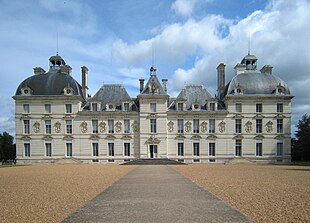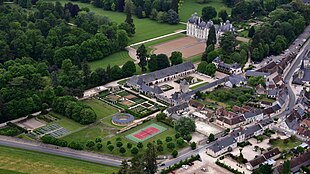Cheverny Castle
Cheverny Castle is a Loire castle in the commune of Cheverny , a few kilometers south of the city of Blois in the Loir-et-Cher department of the Center-Val de Loire region in France .
Building
The castle was built for Count Henri Hurault, General Plenipotentiary for the Orléans Governorate and Vogt of Blois, between 1620 and 1630 in the early and strict classicist Baroque style and is still inhabited today by his descendants, the Hurault de Vibraye family. The site manager was the architect Jacques Bougier from Blois. The decorative painter for the castle was Jean Monier .
Cheverny Castle was long considered a wingless castle with embossed masonry, because nothing was known about the side wings and the courtyard edging that existed until the 18th century. Otherwise, the building is a pavilion that was once a modern pavilion, with each pavilion serving a specific purpose: staircase (central pavilion), living rooms (side pavilions), halls with windows on both facades (medium, smaller pavilions).
interior
The interior of the castle is one of the most important from around 1640.
Dining room
The dining room was partially redesigned in the 19th century for large dinners and ceremonial receptions. The furnishings are based on the decorations of the 17th century: the ceilings and walls are covered with leather and bear the family coat of arms of the Huraults (azure cross and red sun); the open fireplace with a bust of King Henry IV is decorated with fine gold.
Paintings by Jean Monier, which are thematically based on the novel Don Quixote by Cervantes , which was very fashionable in the 17th century, are embedded in the wall cladding . Jean Monier was noticed by Queen Maria de Medici in Blois at a young age. He studied in Italy for 8 years before working for the Queen in Paris. In 1640 he started decorating Cheverny Castle.
Grand staircase
The staircase of honor with a straight run and a platform halfway up the floor reveals the influence of the Italian Renaissance in the Loire Valley. The elegant decor is carved into the white tuff. The motifs used were under Louis XIII. very popular; these include balustrades, garlands, warlike symbols and the various arts (geography, architecture, music, poetry, painting and sculpture).
Private apartments
In addition to the picture gallery with its souvenir and family pictures, the private rooms that were inhabited until 1985 can also be visited. In the yellow room, also known as the “birthing room”, the young mothers received their newborns and presented them to the family. Adjacent to this room are a small red boudoir, a children's room, the couple's room, the family's dining room and the small salon.
Armory
This room, the largest in the castle, has retained its dimensions and its original decoration, painted by Jean Monier in the 17th century. The beamed ceiling "à la francaise" is worth seeing. The wall paneling is decorated with various floral motifs and motto, joke questions and puns in Latin, which were very fashionable at the time. On the carved and gilded fireplace, the gods Mercury and Venus frame the love story of Adonis, with the death of Adonis in the middle, also painted by Jean Monier.
Opposite the fireplace hangs a 17th century tapestry, which is characterized by its fresh colors. It depicts an episode from the world of Greek legends: the kidnapping of Helena , the wife of the King of Sparta, Menelas , by the Trojan prince Paris . This event sparked the Trojan War .
The weapons collection on display dates from the 15th and 16th centuries (two-handed swords, armor, halberds) and the 17th century (swords, crossbows, arquebuses and pistols). Below the tapestry is the armor of the Count of Chambord, which was made for him when he was 4 years old. The chests and suitcases date from the 17th century; the leather-covered case with the coats of arms of France and Navarre belonged to King Henry IV. The empty case alone weighs 70 kg.
King's bedroom
This magnificent room in honor of the king was reserved for high-ranking guests. The paintings tell stories full of adventure and romance. Jean Monier depicted the story of Perseus and Andromeda on the fireplace, the top of the door and on the coffered ceiling. At the bottom of the walls are 30 scenes from the moving love story of Theagenes and Chariclea, a novel from ancient Greece that was very popular during the Renaissance.
The six tapestries from the early 17th century are based on the Odyssey . Their decorative borders are the most beautiful that are known from this era. The large four-poster bed from the 16th century is covered with embroidered Persian silk. The chairs are in the style of Louis XIII, the armchairs in that of Louis XIV. They are upholstered in woven fabrics from Aubusson , the famous manufactory that was made a royal manufacture under the minister Jean-Baptiste Colbert .
Big salon
The salons of the castle have been restored, furnished and inhabited by the respective castle owners over the past 150 years. The rich collection of paintings and furniture gives an insight into the history of French arts and crafts.
The large salon, which was partially restored in the 19th century, has its original decor. The ancestral gallery honors the first Counts of Cheverny: at the entrance to the left between the windows on the south side: Chancellor Philippe Hurault (father of Heinrich, who built the castle) and his wife Anna de Thou; between the windows on the north side: Heinrich's daughter, Elisabeth, in a hunting costume, and on the left her husband, the Marquis de Montglas; on the fireplace: Elisabeth's daughter-in-law, Marie-Johanne de la Carre Saumery, painted by Mignard, the painter of Queen Anna of Austria.
Above the doors are the portraits of personalities associated with the history of Cheverny; the portraits of King Louis XIII. (whose officer was Heinrich) and Queen Anna of Austria hang opposite those of the king's brother, Gaston of Orleans, and his daughter, Anna of Orleans, Duchess of Montpensier.
Opposite the fireplace, two precious paintings frame the mirror; the portrait of Cosimo de Medici, future Grand Duke of Tuscany (whose father sided with Francis I against Charles V), is attributed to Titian . To the right of it hangs the portrait of Johannas von Aragon, the illegitimate granddaughter of Ferdinand I (brother and successor of the German emperor Charles V), which comes from the studio of the Italian painter Raffael .
The furniture in the Great Salon is from the 17th and 18th centuries; These include armchairs from the time of Louis XIV, a very rare writing desk from Louis XIV and a desk from Louis XVI, made by Stockei, the cabinet maker of Queen Marie Antoinette .
Traditional hunting law
The pack of around 100 hunting dogs that the lord of the castle still keeps is famous. The three-colored dogs are a breed of English Foxhound and French Poitevin . As a tourist attraction, there is a spectacular feeding every day outside the hunting season. Despite the general ban on French hunting , the owner of the castle still has the right to hunt up to 25 deer every year.
Trivia
The castle served the comic artist Hergé as a model for Mühlenhof Castle , the later residence of Captain Haddock in the stories of Tintin . At Mühlenhof Castle, however, part of the side wings were left out. Since 2001 there has been a Tintin exhibition in an outbuilding of Cheverny Castle, which, like all products marketed in connection with this comic, is officially supported by the Hergé Foundation.
literature
- Jean-Marie Pérouse de Montclos, Robert Polidori : Castles in the Loire Valley . Könemann, Cologne 1997, ISBN 3-89508-597-9 , p. 170-177 .
Web links
- Cheverny Castle website (multilingual)
Cheverny Castle as a 3D model in SketchUp's 3D warehouse
Individual evidence
- ↑ Serge Bathendier, Françoise Chaffin (ed.): Chateaux de la Loire. De Briare à Angers. Hachette, Paris 2014, ISBN 978-2-01-245196-4 , pp. 158-159.
Coordinates: 47 ° 30 ′ 1 ″ N , 1 ° 27 ′ 29 ″ E






